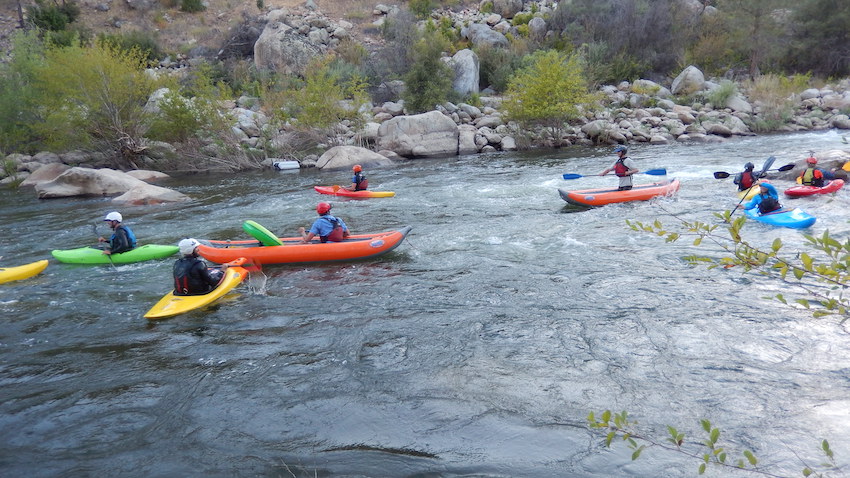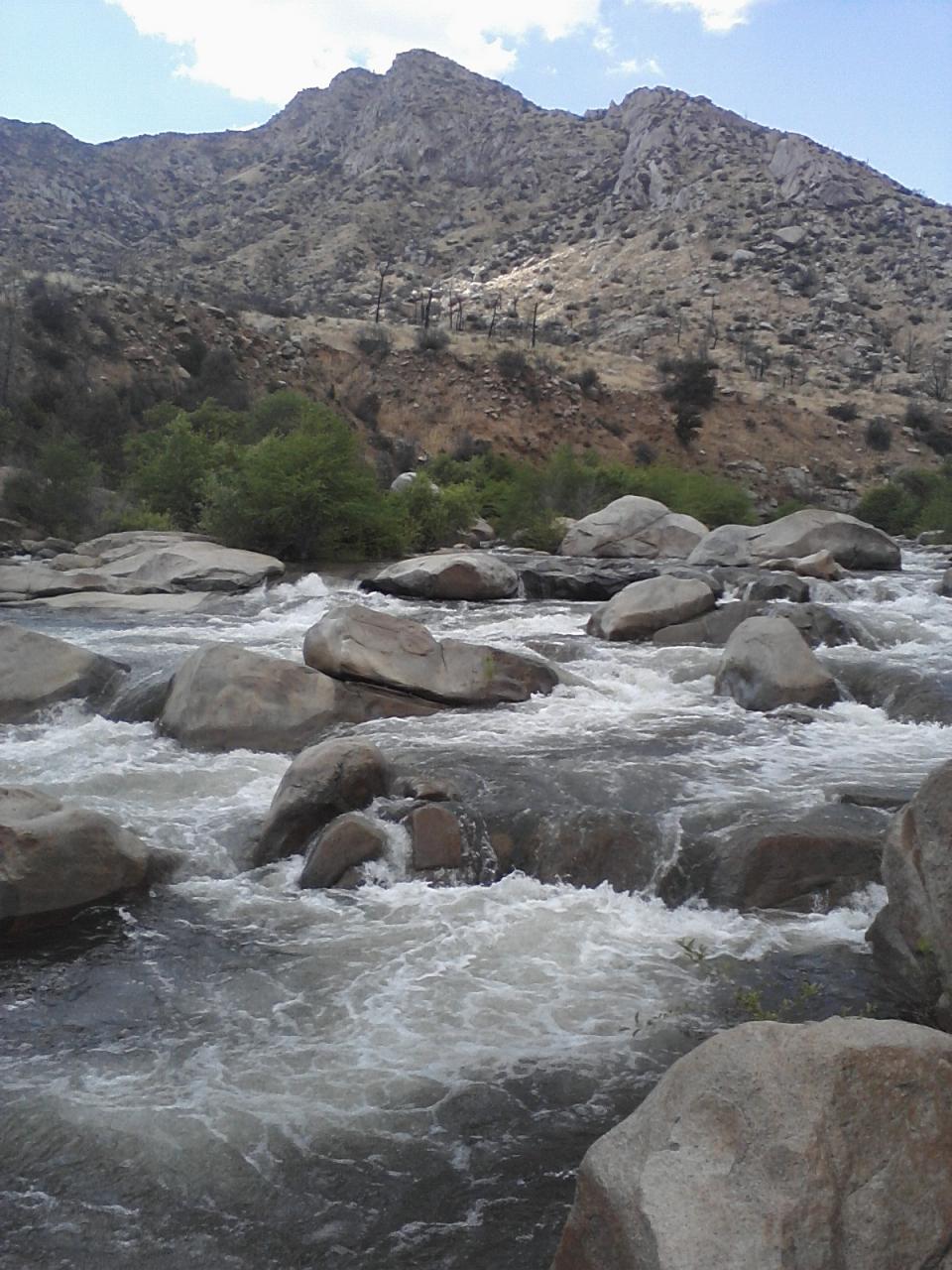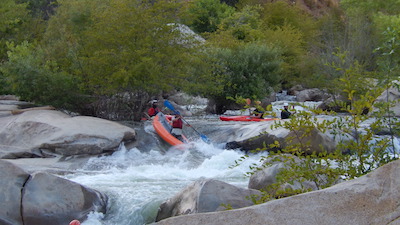Fed by snowmelt from Mt. Whitney, the highest peak in the contiguous United States, the Kern River courses some 165 miles down through southern Sierra Nevada in California before reaching human-made Lake Isabella, exiting out the other side via the spillway and then continuing south towards Bakersfield. Known as a National Wild and Scenic River, the Kern is famous for its whitewater rafting and kayaking, along with fly fishing and remote trail systems for hiking, backpacking and horse packing. A few miles north of Lake Isabella sits the town of Kernville. The economies of Kernville and the town of Lake Isabella, other than some agricultural production, are characterized primarily by recreation and tourism. Other small unincorporated communities in the area also share similar characteristics.
During peak season, roughly the months between the US holidays of Memorial Day and Labor Day, the river and lake are visited and used by hundreds of thousands of people in this area of California, from campers to fishers to kite surfers and whitewater enthusiasts to tubers and stand up paddlers. Annually, some one million people visit the Kern River Valley, which is home to only 12,000 year-round residents.
Kern River Valley: A History of Tourism
To understand the popularity of the Kern River Valley (KRV), we need to take a look back in history. In 1975, the U.S. Forest Service granted the first permit to run whitewater rafting trips down the Upper Kern. A year later, additional permits were requested, but the forest service balked as local opposition to recreation on the river mounted. Nevertheless, a year later, in 1977 and through 1979, permits were handed out and trips ran. In the 1980s, permits for the Upper Kern and the Lower Kern proliferated, putting the Kern River on the whitewater map to stay.
During that same time period, whitewater kayaking was growing in the Sierra Nevada region of California as well. In 1972, Kernville’s Riverside Park, with leadership from Tom Johnson and support from the U.S. Army Corps of Engineers, saw the addition of an Olympic training course for whitewater kayaking. Years later, in 2003, the first World Cup event in kayak racing ever held in the U.S. took place in Kernville. At the Athens Olympics in 2004, Kernville local Rebecca Giddens won a silver medal in the K-1 event, coached by her husband Eric. Together they founded Kern River Brewing Company (KRBC), which is now 100% employee-owned. It is beta central for all things river talk, as well as mountain biking, hiking, climbing, and venturing up the road to see the sequoia trees. You can also see the silver medal winning kayak at KRBC.
Lake Isabella, a few miles down the road from Kernville, was built and completed in 1953, serving as flood control and providing irrigation opportunities to local agriculturalists that are now dependent on the lake. It also serves for fishing and boating recreation, along with being a Southern California destination for kite boarding and kite surfing. More recently, stand up paddleboard enthusiasts have joined in on the fun available on Lake Isabella.
Sustainable Tourism vs. Over Tourism
All of this is to say that the Kern River Valley is a water lover’s dream location, having been a more formalized water recreation hub for more than fifty years. Over the past decade or so, though, the valley has seen visitation skyrocket, with the pandemic years being somewhat of an exception,. It was also a place for getting away during those years as well. All told, in any given summer weekend, the central town of Kernville, with only a couple thousand residents, can see visitor numbers reach upwards of 30,000 people in and around town, up and down the river, and the nearby foothills and shores around the lake.
On a recent trip, I chatted with employees at the grocery stores, the brewery, and in shops and restaurants around town. One theme ran through all of those conversations: concern about too much tourism, aka over-tourism. My own observation, with some 25 years of going to the KRV as a reference point, was that the local residents were not wrong.
I was reminded in these conversations about the idea of sustainable tourism, having studied it, experienced it, practiced it, and now teaching it in San Diego. How might the idea of sustainable tourism apply to remote places like the KRV? More so, for us visitors, how might we become more responsible visitors?
Check list to minimize your potential impact anywhere:
1. Pack out your trash at campgrounds. It is not okay to pile your trash up around the trash receptacles that are already full. Carry extra garbage bags with you and take it home. It also lessens the challenges placed on public lands managers and local sanitation services.
2. Van lifers should not park in front of local people’s homes. Don’t change your clothes in view of homes where residents live.. Yes, there are public streets, but please be mindful and considerate.
3. Respect/observe “No Camping” signs. We don’t need a larger ecological impact footprint.
4. Lodge in locally owned businesses. Stay with locals in their homes/additional dwelling units if they offer them. While difficult to do, dig deeper in your rental research to see if the house you want to rent is locally-owned or whether it’s owned by investors living hundreds of miles away.
5. Buy local. Research shows that the dollars (any currency worldwide) stays in the local economy longer when you buy local. Go to the local Saturday market and buy a cup of coffee, get some fresh seasonal fruit, pick up some honey and gift it as part of the tip to your rafting guide.
6. Use local guides from the companies that are independently operated and with a history of training and hiring people from the immediate area.
7. Your vacation doesn’t give you the right to be drunk, loud and obnoxious. Whether you’re camping or are in your hotel room or house rental, if it’s 10 p.m. it’s time to turn the noise off, including your exuberant voice(s).
8. Respect the river/water/wherever. Do not take glass bottles into the river, ever. You want to drink a beer while tubing? Check local ordinances first and, if you still want to do it, drink from a can, and be sure you pack it out.
9. Talk to people at the local businesses. Ask them how to be a better visitor. I learned about a local non-profit I wasn’t aware of that works to protect the natural resources of the KRV. My donation will be forthcoming when I sit down and make my year 2025 contributions to organizations I want to support.
10. Eat from locally-owned restaurants. In Kernville, for example, be sure to eat at Cheryl’s Diner. If you’re lucky she might sit down and play the piano while you’re noshing on your home cooked meal.
11. Don’t buy all of your groceries at home. Buy them from the local stores. Sure, maybe they won’t have everything that you typically eat, but that’s the point! Eat what’s locally available, including locally produced food.
12. Follow all public lands rules and regulations, especially fire safety ones, which might mean you can’t have that campfire. Sit by the river and gaze at the stars.
Whether we are visiting a local, seasonally inundated area like Kernville and Lake Isabella or just passing through some of these great communities that host our outdoor activities, we can all be a little more aware of how to lessen our impact on the environment and support the local community while we are at it. Happy trails!
-- Respectfully, James Murren














